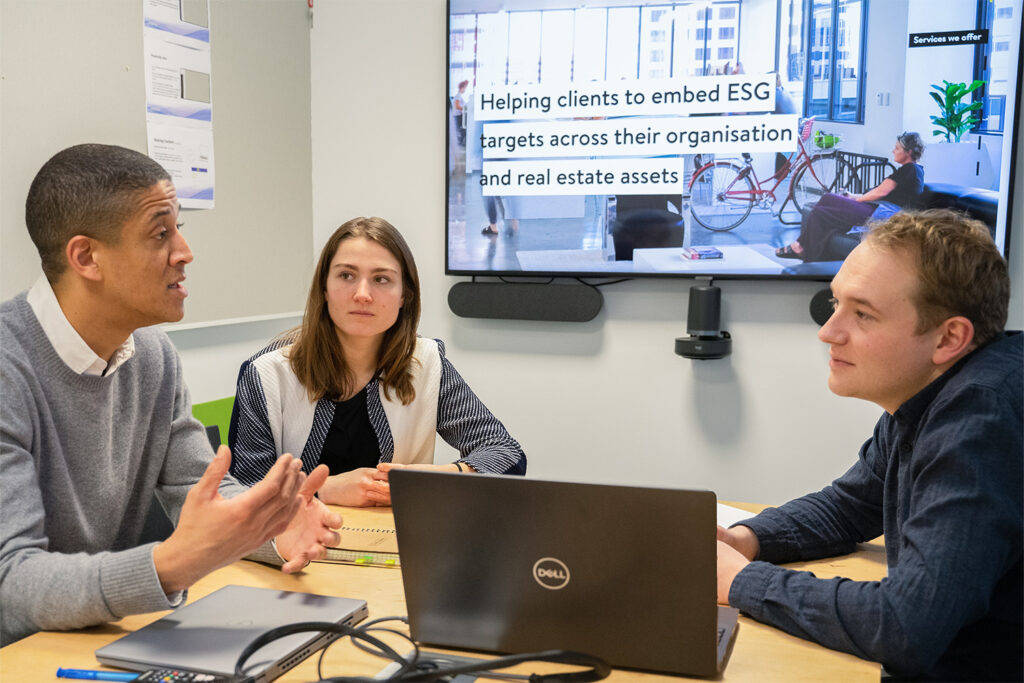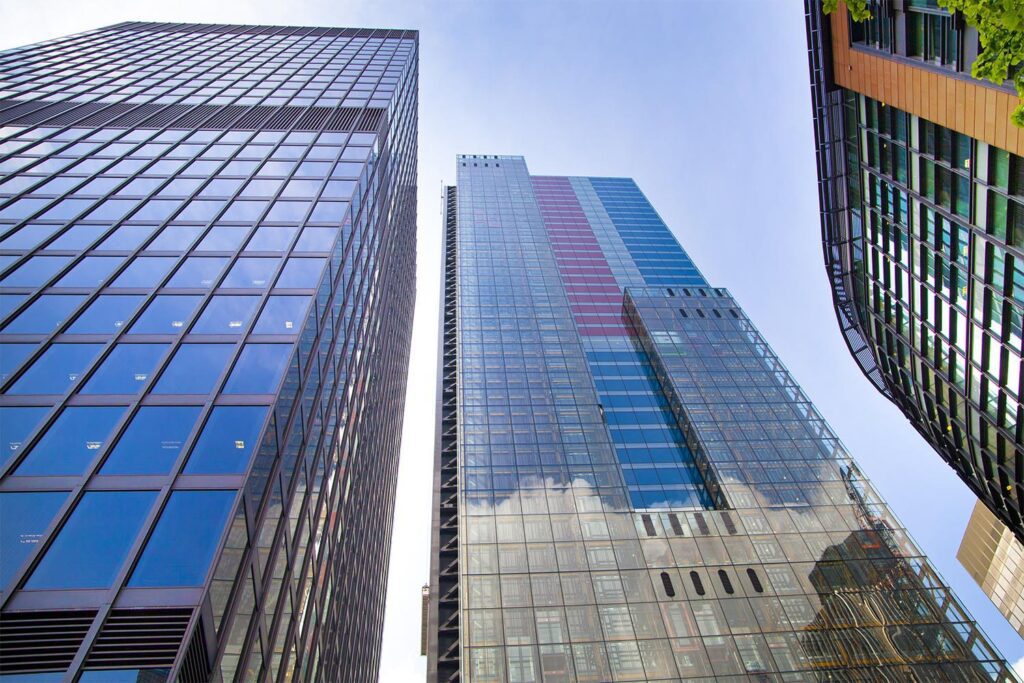What role does ESG play in the built environment?
What role does ESG play in the built environment? Here, we look at what ESG means for our industry and how Buro Happold delivers positive outcomes for clients.
What is ESG?
There are three pillars of ESG: environment, social and governance. ‘Environment’ refers to issues such as the climate, emissions and resource use, while ‘social’ is the human aspect and involves health and wellbeing, modern slavery and labour standards. ‘Governance’ focuses on an organisation or businesses leadership and corporate behaviour.
An ESG framework assesses continuing sustainability and performance of an organisation or business, considering risk management, key stakeholder expectations and an ever-tightening regulatory landscape. ESG work looks at potential opportunities presented to a business across the three pillars of environmental, social and governance.
There are many positive outcomes from ESG work, including lower carbon and environmental footprints, increased understanding of impacts on society and reduced regulatory or compliance risks, operational cost savings and brand management.
ESG and the built environment
ESG is about making an entire organisation, rather than just individual infrastructure, buildings or assets, more resilient and sustainable. For this reason, it is inherently more challenging than acting at a building or asset level. It’s a genuine ‘wicked’ problem with the themes within the ‘E’, ‘S’ and ‘G’ all strongly interrelated. Working on ESG therefore requires a systems approach.
Increasingly, the built environment turns its attention to ESG. There are many areas in which the built environment has an impact that are relevant in ESG discussions. One that garners a lot of attention is the emissions (both operational and embodied) that come from buildings. There is a focus on driving down greenhouse gas emissions from construction and renovation and a building’s lifetime operational emissions.
Other common areas of focus for positive outcomes include how new or re-developments can support the regeneration of our natural environment and biodiversity, encouraging development of the circular economy (with its reduction of raw material extraction and subsequent environmental damage) and reduction of air, water and land pollution.

Rob Gillies is global environment social governance manager at Buro Happold. He said, “There is no official weighting between the three pillars of ESG but often we see that discussions miss out the ‘S’ and the ‘G’. One of the main reasons for that is a lot of the work in the ESG regulation space is driven by statutory reporting necessary for large companies; they have to report it publicly, which drives internal activity on metrics, targets and plans.
“The ‘social’ pillar is coming under the spotlight after years of the environment overshadowing it. Developers, clients and contractors, among others, are growing in awareness of social value. Towards the top of their priority list should be understanding, affecting and monitoring how our buildings, developments and cities impact their communities and wider (often global) supply chains.
“A lot of the focus of that has been in the environmental space, specifically on carbon emissions and climate change risk. It is perhaps easier to develop frameworks and standards around things that are measurable (like carbon emissions), whereas when we turn to the ‘S’, social value is harder to measure consistently across different geographies and sectors. The ‘environmental’ is a little ahead of the other pillars, but ‘social’ and ‘governance’ are catching up fast.”
Buro Happold and ESG

We know that clients recognise the importance of ESG and are under pressure to deliver. There are many ambitious climate related directives in different parts of the world, such as the EU Sustainable Finance Disclosure Regulation (SFDR) or the EU-Taxonomy regulation in Europe. We also know that it is not only about environmental work, despite the inevitable (and important) attention it garners; the social and governance side must not be neglected, but all three pillars looked at holistically.
Because of where we operate and the kind of work we do, we are very close to the key components required to enact ESG changes. The disciplines we work in fundamentally drive ESG value.
Rob Gillies, global environment social governance manager
Buro Happold considers ESG as a continuous cycle of innovation. We help to mitigate risk, maximise positive impact, create opportunity and drive real value. ‘Assess’ means we support clients in identifying what their biggest concerns are and what they wish to achieve. ‘Target’ is a process of setting a vision and setting achievable targets. ‘Plan’ identifies the required actions that will make these targets a reality. ‘Implement’ means the delivery of tangible improvements. A fundamental part of ESG work is ‘report’ – we support on reporting the progress of our clients.
Buro Happold’s ESG experts provide support to embed an ESG focused approach across an organisation and its assets. We can help businesses to develop ESG strategies and frameworks that are tailored to their sector, and provide practical solutions to embed these across portfolios, developments and assets.
Our expertise in ESG topics include carbon (energy use and efficiency, energy sources and renewables, and materials), water (use and reuse), materials, health and wellbeing, purpose and values, and ESG programme management.

Buro Happold has worked with Royal London Asset Management (RLAM) to create and embed an ESG and sustainability strategy across the vast network of assets it manages. When considering ESG, it was critical for RLAM to understand how to manage and mitigate risks in a way that will lead to value creation for their assets.
We helped RLAM analyse and set ESG targets aligned to what mattered most to them and the assets they manage. This was reflected in a sustainability strategy and framework which became an integral part of RLAM’s ESG property development strategy. We supported RLAM with visioning, goals and key performance indicators, as well as ESG action plans, guidelines and best practices. With support from Buro Happold, RLAM continues to create environments and communities that demonstrate their ESG commitment and deliver social value.
An ongoing relationship with Aviva Investors relevant in ESG discussions: Buro Happold is working with Aviva Investors to embed ESG and sustainability standards throughout its enormous development portfolio. This is to support them in achieving ambitions of net zero carbon by 2040.
We supported in understanding and navigating around emerging standards around embodied carbon, social value and biodiversity. Understanding embodied carbon within their portfolio was critical. Wellbeing and social standards were also considered; we integrated requirements into a sustainable design brief and developed design guides for the design teams. Buro Happold’s Sustainability Associate Director, Trevor Keeling, has been seconded to Aviva for the project duration.
As well as investors and asset owners, Buro Happold delivers ESG consulting for a range of clients including corporations, city and local authorities, colleges and universities, research and cultural institutions, non-profit organisations and real estate developers. Rob Gillies said, “Because of where we operate and the kind of work we do, we are very close to the key components required to enact ESG changes. The disciplines we work in fundamentally drive ESG value.”
Learn more about Buro Happold’s ESG advisory services here.


